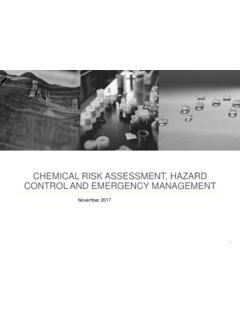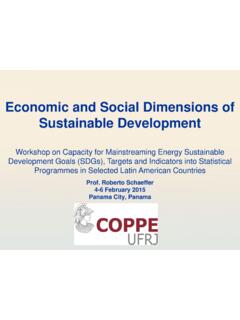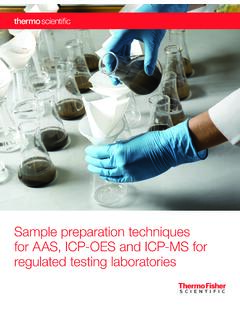Transcription of WASTEWATER TREATMENT PLANTS: DESIGN AND …
1 1 Version TREATMENT PLANTS: DESIGN AND OPERATION ASPECTSN ovember 20172 THE PROBLEMWhat challenges might occur from insufficient WASTEWATER TREATMENT ? Brainstorm as a group and take notes in your workbook, exercise (22-1).3 LEARNING OUTCOME & RESOURCESL earning Outcome Understanding of WWTP designs, TREATMENT technologies and the sequence of treatments. Knowledge of the mapping of these technologies against the chemicals and processes involved in WPU and the control measures to ZDHC to complimentary excercises in your workbook. 34 Introduction To WASTEWATER TREATMENT 5 TERMSTermDescriptionAnaerobicWithout oxygenAerobicWith oxygen, in activated sludge plants or in aerobic pondsAnaerobic digestion/degradation/treatmentterms used interchangeably and mean breaking down anaerobic matter Digestate/ digester residue/ digested organic matterEffluent from a digester, the liquid product of the anaerobic digestion processBiogasGas produced by microorganisms in anaerobic process (typically 66% methane content)Biogas digester/ anaerobic digesterA covered vessel (or reactor)
2 In which anaerobic digestion occurs6 COD (Chemical Oxygen Demand) LOAD THROUGH VARIOUS TEXTILE PROCESSES ProcessCODcontent in mg O2 dye liquors reactive dyeing400 dye liquors dispersing dyes or vat dyeing finishingpadding TREATMENT Plants8 WASTEWATER TREATMENT PROCESS WastewaterTreatmentTotal water TREATMENT system, employed to treat the waste/effluent water from industry. ( Image: courtesy of wikipedia)Pre-TreatmentRemoval of insoluble particles from reaching TREATMENT zone, which may hinder TREATMENT operation. 1) Grit removal, 2) flow equalisation,3) Fat and grease removal (Image: Courtesy of Hydro International)Primary TreatmentBased on the effluent the primary TREATMENT is to remove the total suspended solids by suspending in to coagulant -results in sludge.
3 ( image: Courtesyofovivo)SecondaryTreatmentReduct ion of chemicals either by aerobic, (with oxygen ) or anaerobic, (without oxygen) reactions -results in sludge.( Image: CourtesyofApaHeuristic)Tertiary TREATMENT Removal of residual components like colour, sludge remains and resulting clear water with the specification to meet the environmental requirement (Image courtesy-Pure aqua)9 WASTEWATER TREATMENT PLANT TYPE 1 Industry Waste WaterSievingGrit RemovalEqualisation / NeutralisationDischargeSedimentationCoag ulation and FloculationPrimary Clarifier10 WASTEWATER TREATMENT PLANT TYPE 2 Industry Waste WaterSievingGrit RemovalEqualisation / NeutralisationDischargeSedimentationAnae robic / OptionalPrimary ClarifierAerobicAir11 WASTEWATER TREATMENT PLANT TYPE 3 Industry Waste WaterSievingGrit RemovalEqualisation / NeutralisationDischargeSedimentationAnae robic / OptionalPrimary ClarifierAerobicAirBiological Treatment12 WASTEWATER TREATMENT PLANT TYPE 4
4 Industry Waste WaterSievingGrit RemovalDischargeSedimentationPrimary ClarifierChemical / Advanced OxidationBiological TreatmentNeutralisation13 WASTEWATER TREATMENT PLANT TYPE 5 ZERO LIQUID DISCHARGE (ZLD) SYSTEMI ndustry Waste WaterSievingGrit RemovalCollection / NeutralisationChemical / Advanced OxidationAirBiological Aerobic / AnaerobicChlorine Gas / Decolouring AgentFloculation/ CoagulationSedimentationPrimary ClarifierCooling TowerTrickling TowerMicro FiltrationUltra FiltrationRO1 / RO2 / RO3 NanoFiltrationIon ExchangeMEESalt ReuseWater Reuse14 WWTP CHINA 1415 LINK BETWEEN WASTEWATER TREATMENT AND SUBSTITUTION OF HAZARDOUS CHEMICALS Depending on the WASTEWATER TREATMENT technologies employed by the facilities.
5 The hazardous chemical residues appear in the discharge water stream or in is important to understand and identify the type of chemicals and the concentration levels of the chemicals which can be broken down to CO2. H2O. Other safer hazardous chemicals which cannot be treated by the WWTP technologies employed should be Restricted. Substituted. Controlled. 16 METHODS FOR WASTEWATER TREATMENT PLANT PERFORMANCE TESTING Standard Methods ASTM 5210D Biochemical Oxygen Demand. RespirometricMethod (RespirometricOxygen Uptake). Standard Methods ASTM 2710B Oxygen-Consumption Rate. (Specific Oxygen Uptake Rate; Dissolved Oxygen Probe Method).
6 OECD 209 Activated Sludge, Respiration Inhibition Test. ASTM D5120 Standard test Method for Inhibition of Respiration in the Activated Sludge Process. Short-Term BOD Test (EZ-BOD instrument test for influent or effluent BOD-5 estimation). suspended Solids (Photometric Method). CONTRAL Biodegradation Kinetics. Microscopic Evaluation of Biomass (Higher Forms and Filaments). 17 ACTIVITY ROLE PLAYYou are the WASTEWATER TREATMENT Plant Manager. Explain the benefits of effective WASTEWATER TREATMENT to your colleague in HR, who wants to understand how WASTEWATER TREATMENT links to the protection of the environment and substitution of hazardous notes.
7 Workbook, Exercise (22-2).18 Pre- TREATMENT 19 PROCESS FLOW PRE- TREATMENT ScreeningGrit removalGrease removalpH neutralisationHomogenisationThe screen size to be selected on the basis of the lower particle size can be sieved and of sand and gravel, cotton fluff, other heavy solid materials, higher specific gravity items other than organic biodegradable solids, food waste. Removal of oils, greases from machine and non miscible effluent load and effluent characteristics need to be considered before further processes. The primary TREATMENT is the deciding factor to maintain the effluent load and effluent characteristics need to be considered before further processes.
8 Consideration for the average pH based on the process house variable to be made 20 OVERVIEW TREATMENT POSSIBILITES PRE- TREATMENT Typeof treatmentDescriptionUsed in order filtersTo remove the insoluble particles from effluentGrit RemovalParticleseparator Separates heavier inorganic particles -specific gravity about separatethe oils and greaseRemoval of oils, greases from machine and non miscible compoundspH NeutralisationTo correct the pH for further treatmentsThe primary TREATMENT is the deciding factor to maintain the pH HomogenisationCollection and effluent standardisation To make the effluent pH uniform, keep the variables of average effluent load and effluent characteristics at low21 SCREENINGThe firstunit operationgenerally encountered in WASTEWATER TREATMENT plants is removes larger materials and coarse solids from raw WASTEWATER metals to prevent damage and clogging of downstream equipment, piping, and appurtenances.
9 Two types of screening processes: Manual. REMOVAL AND SEDIMENTATIONGrit removal, hydro-mechanical process: Various techniques. This activity follows the screening. Techniques may vary based on plant , physio/chemical activity: Natural. Chemical based coagulation. This activity is follow the grit removal. Removal of total suspended DIFFERENT SCREENS Simple bar screen manual cleaning. Appropriate for low particle loaded effluent. Flat Screen Continuous screening. Screw removes the particles to collection Screw Continuous screening. Scratch filter type particles are collected.
10 Used in sticky and accumulative Spiral Continuous screening. Particles are collected with a screen in rotation. Used for the continuous particle load in Screen24 EQUIPMENT DIFFERENT SCREENS Screw screen. Appropriate for the flow involving low level and automated collection screw screen Continuous screening. Separates the particles by passing the effluent through continues conveyor type operation screen. Belt fine screen Continuous screening. Appropriate for heavy particles spill way Stationary belt fine screen without screen25 PRE- TREATMENT EQUIPMENT SLIDING SCREEN SIEVESO peration scheme for sliding screen26 GRIT AND GREASE REMOVAL -EXAMPLESG rease removal Conveyor type grit removalRotating bar chamber cleanerGrease and scum remover27 GRIT AND GREASE REMOVAL PROCESS VIDEOR eference: Work Videos- NEUTRALISATIONAll neutralisation processes, irrespective of type of waste, share several basic features and operate on the principle of acid-base reaction.



